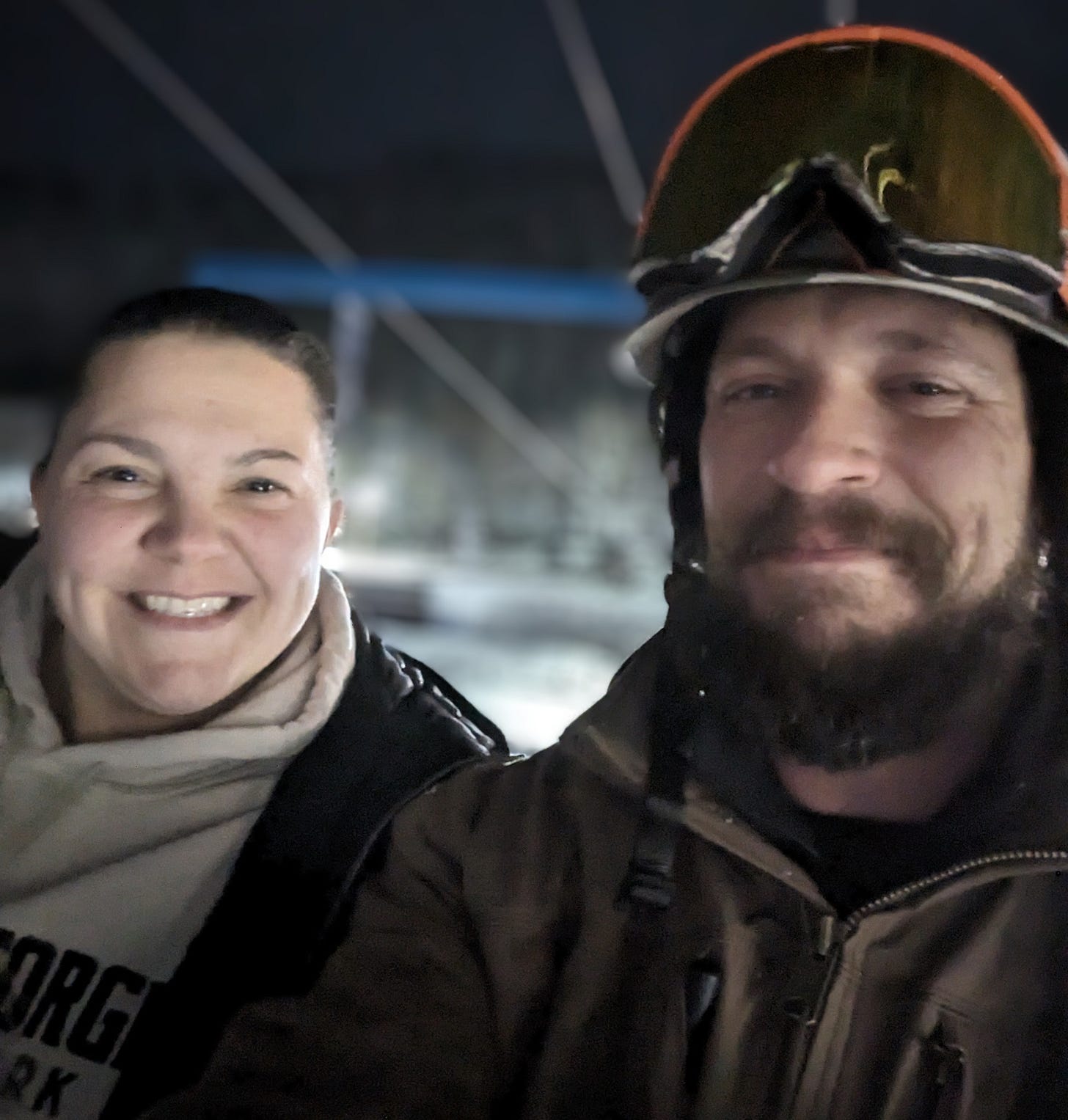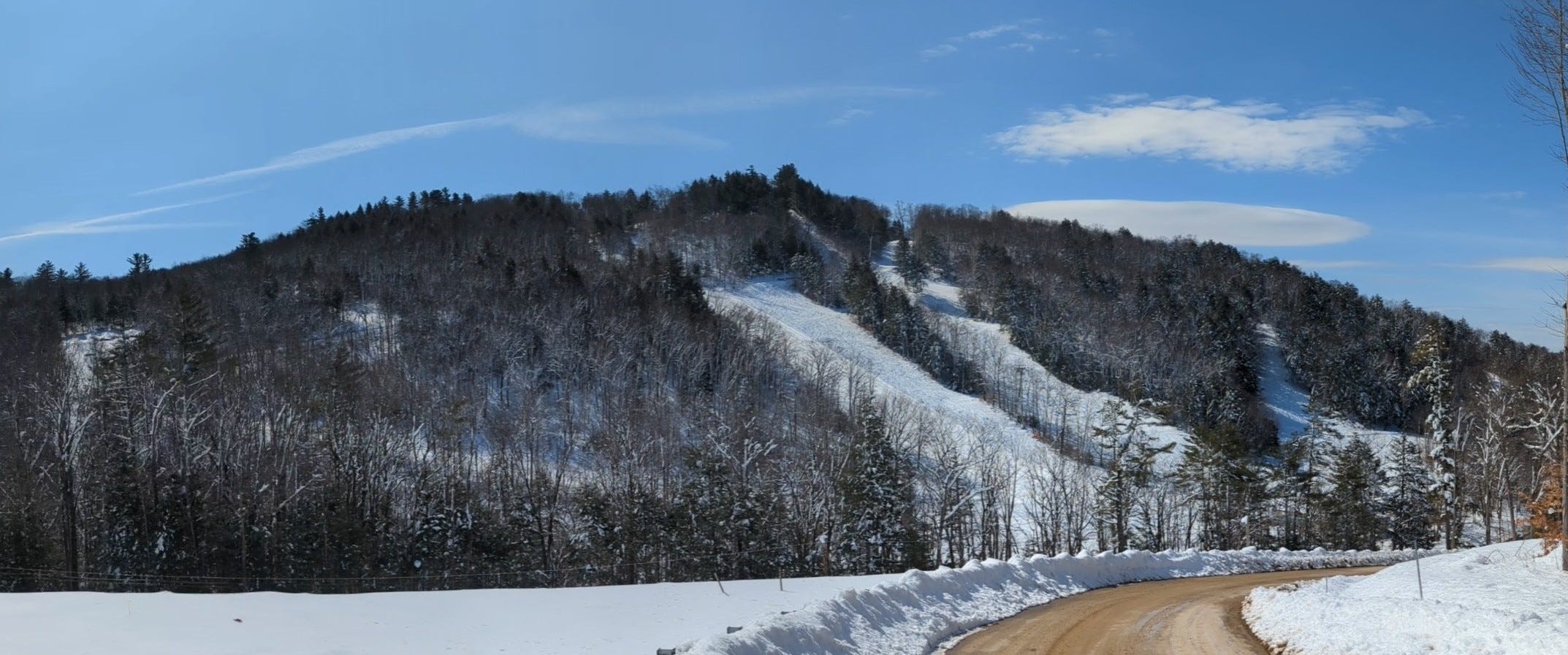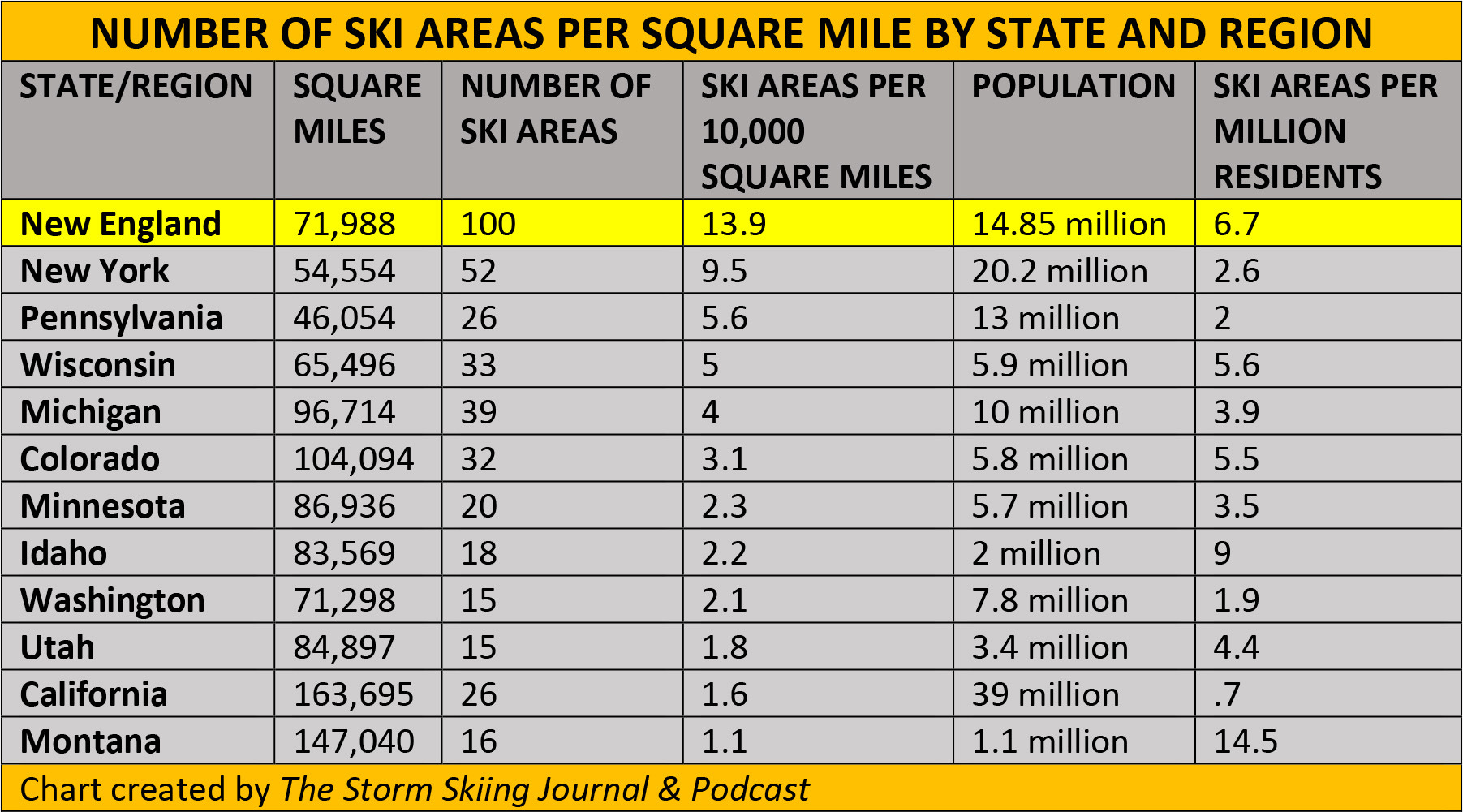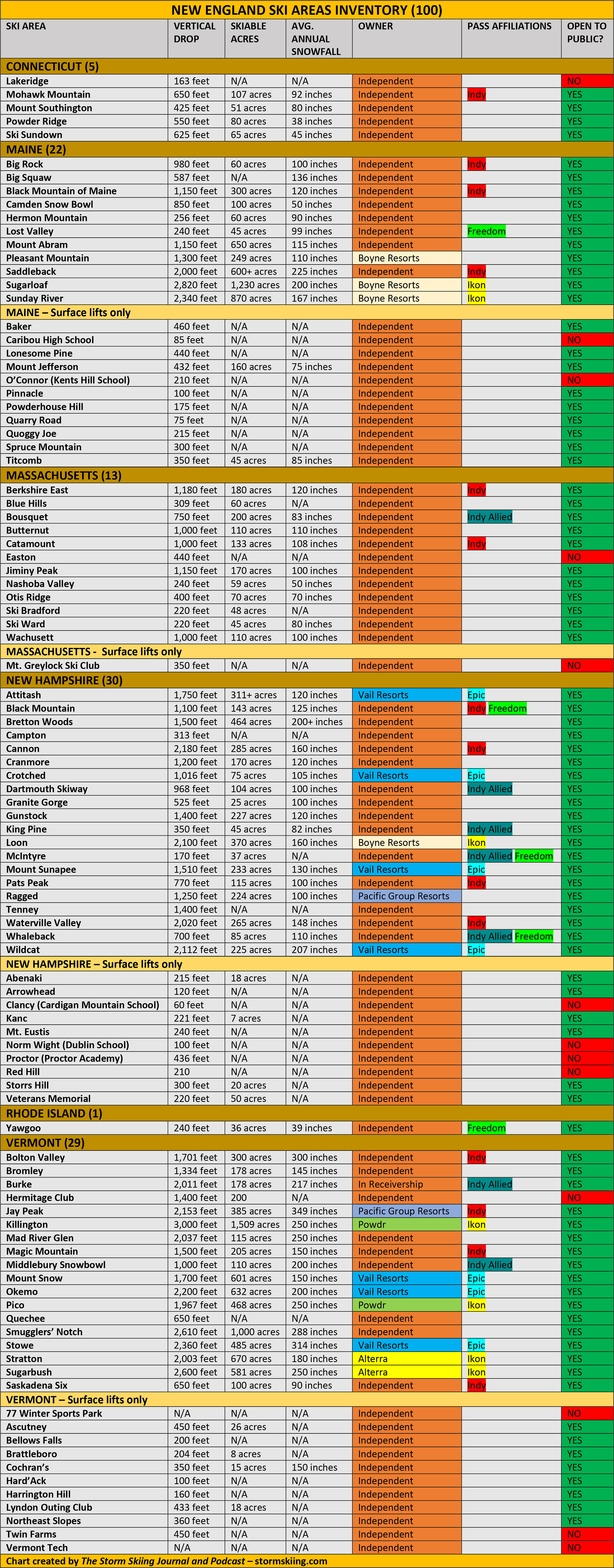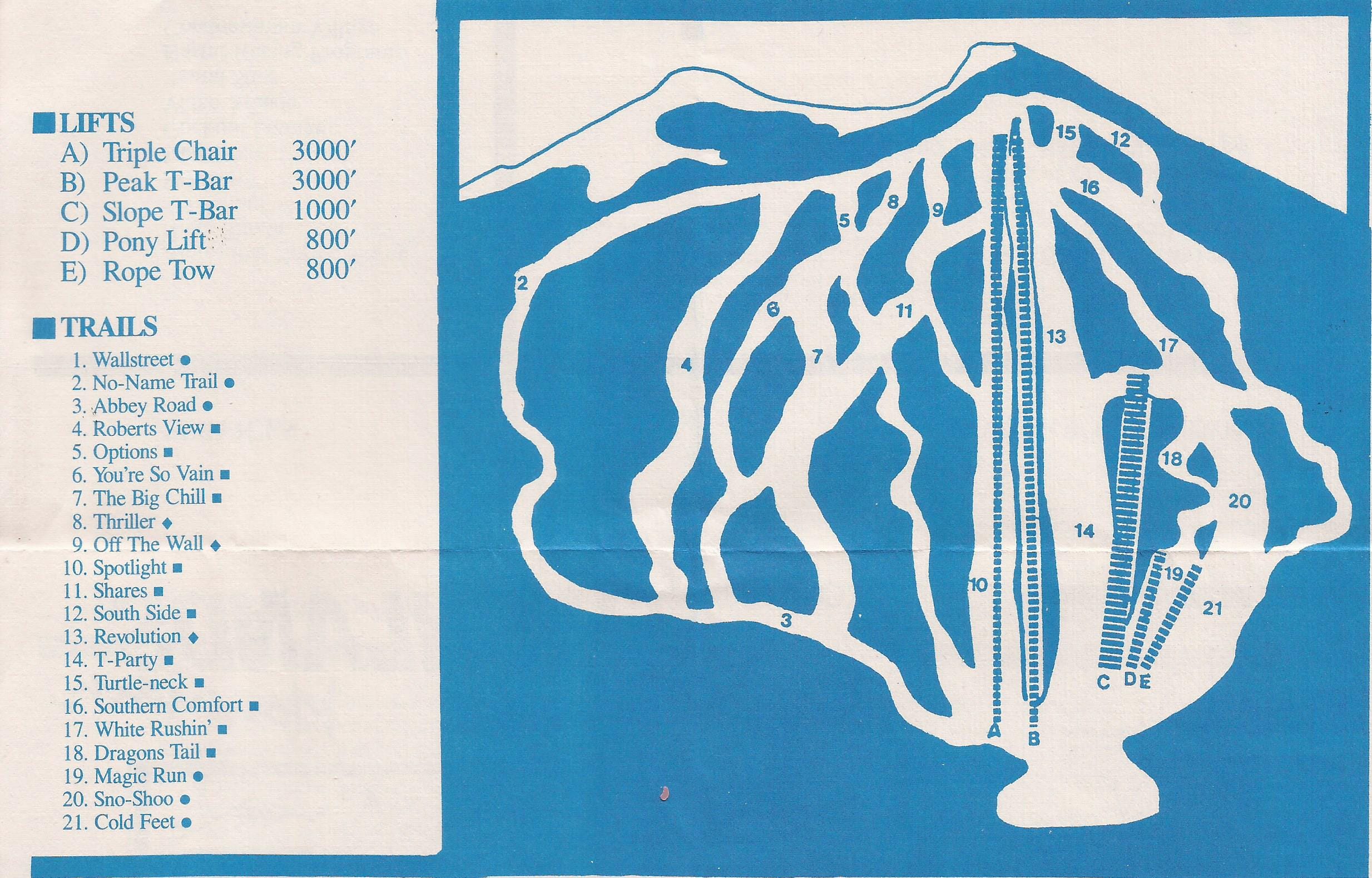Who
Keith Kreischer, General Manager of Granite Gorge, New Hampshire
Recorded on
May 30, 2023
About Granite Gorge
Owned by: Granite Gorge Partnership LLC, a group of local investors
Located in: Roxbury, New Hampshire
Year founded: 1959
Pass affiliations: None
Reciprocal partners: None
Closest neighboring ski areas: Crotched (32 minutes), Brattleboro (32 minutes), Bellows Falls (35 minutes), Pats Peak (37 minutes), Mount Sunapee (50 minutes), Arrowhead (50 minutes), Ascutney (58 minutes), McIntyre (1 hour), Hermitage Club (1 hour, 6 minutes), Mount Snow (1 hour, 9 minutes), Magic (1 hour, 3 minutes), Wachusett (1 hour, 7 minutes), Bromley (1 hour, 13 minutes), Berkshire East (1 hour, 13 minutes), Okemo (1 hour, 13 minutes), Veterans Memorial (1 hour, 14 minutes), Ragged Mountain (1 hour, 16 minutes), Stratton (1 hour, 18 minutes)
Base elevation: 800 feet
Summit elevation: 1,325 feet
Vertical drop: 525 feet
Skiable Acres: 25
Average annual snowfall: 100 inches
Trail count: 17 (2 expert, 3 advanced, 5 intermediate, 7 beginner)
Lift count: 3 (1 double, 1 handletow, 1 carpet)

Why I interviewed him
It doesn’t happen often, these comebacks. Ski areas die and they stay dead. Or they die and return and die again and then they’re really gone.
We’re at a weird inflection point. After decades of exploding numbers followed by decades of divebombing ranks, the number of U.S. ski areas has stabilized over the past 20 years. Most of the ski areas that are going to die already have. Most of the ones that remain will survive indefinitely. Yes, climate change. But this has been a long-simmering storm and operators have strung lines of snowguns like cannons along a castle wall. They are ready to fight and they will.
They have plenty to fight for. In most of U.S. America, it is all but impossible to build a new ski area. Imagine if no one could build a new restaurant or grocery store. The owners of existing restaurants and grocery stores would rejoice, knowing that anyone who wanted to eat out or buy a banana would have to do it through them. Such is the state of U.S. skiing – what we have is all we’re ever going to get*. The established mountains are not exactly monopolies, but they do not have to worry about unexpected new competition, either.
There is one hack: if a would-be owner can find an abandoned ski area, the path to selling lift tickets and hauling weekenders up the incline becomes infinitely easier. It’s the difference between fixing up a junkyard car and assembling one from the raw elements of the earth. You’d have a better chance of building a time machine out of cardboard boxes and a Nintendo Game Boy than you would of constructing a ski area on a raw New England hillside. But find one already scarred with the spiderweb of named trails, and you have a chance.
It’s not a good chance. Ski areas do come back: Saddleback in 2020, Tenney and Granite Gorge in 2023. Les Otten may bring the Balsams Wilderness back as a mega-resort. But most simply fade. There are hundreds of lost ski areas in New England – many times more have died than survived. Many big and established ski centers evaporated: Mt. Tom, Brodie, Crotched East, King Ridge, Moose Mountain, Mt. Whittier, Maple Valley, Plymouth Notch, Snow Valley. Empty lifts still swing over many of these mountains decades after they went bust, but none ever found its way back.
So why this one? Why Granite Gorge? A small ski area in a state stuffed with giant ski areas, many of them a mainline shot off the interstate from Boston. Once the joint closed after a rough winter in 1977, that should have been it. Another lost ski area in a state littered with them.
But then Granite Gorge re-opened, miraculously, improbably, in 2003, under Fred Baybutt, who also ran a local construction company with his family. Baybutt added snowmaking and night skiing, built a new lodge and a new bridge over from Route 9. He bought a used Borvig double and ran it to the summit.
But the ski area never really found momentum under Baybutt. By 2018, the chairlift had ceased operations. The ropetow and carpet continued to spin, but in August 2020, Baybutt died suddenly, and the ski area appeared to die with him.
Except that it didn’t. Granite Gorge is back. Somehow, this 525-vertical foot, low-elevation molehill whose direct competitors include basically every ski area in Vermont, New Hampshire, and Massachusetts has more lives than a cartoon coyote smashed under an anvil. It’s one of the best stories in New England skiing right now, and I had to hear it.
*With rare exceptions, such as the forthcoming Mayflower, Utah.

What we talked about
What it’s like to take that first general manager job; an overgrown mess; “I had to keep in mind that there was going to be an unlimited amount of punches that were going to be dealt”; how a busted Ford Taurus and a can of Red Bull foreshadowed the renaissance of Granite Gorge; Kreischer’s messianic, decade-long quest to rescue Granite Gorge; how an ownership group “who really just wanted this thing back in the hands of the community” came together; advice for up-and-comers in the ski business; trying to save the lost Tanglwood ski area in Pennsylvania or Maple Valley in Vermont; Granite Gorge under the Baybutt family, the previous owners; Keene, New Hampshire; the rabid outdoor culture in the Northeast; how this time is different at Granite Gorge; fixing the bridge back to the ski area; helping ownership understand the enormous capital needs; the power of admitting your shortcomings; “if you don’t know something, you need to find someone who does”; the comeback season was “awesome”; much love for Mountain Creek; finding a niche at Nashoba Valley; reviving the Granite Gorge double chair; why the ski area removed the lift’s mid-station; Granite Gorge’s snowmaking footprint and aspirations; how the ski area’s new mountain bike operation will enhance glade skiing; surviving as a small ski area in a big ski state; night skiing; building terrain parks at an appropriate scale for mortals; running a mountain as a dad with five children; keeping lift tickets and passes affordable; a parking shortage; and competing against megapasses.
Why I thought that now was a good time for this interview
I first connected with Keith sometime last spring, when he shot me an email with a promising update on Granite Gorge. The ski area was re-opening, he said, but I’d have to keep it to myself for the time being. Shortly after, the new ownership group officially named him general manager, and by August he was whacking weeds from beneath the Granite Gorge sign on Route 9 and brushing ticks off his legs.
Excited as I was about this news, I generally don’t ask folks to join me on the podcast until they’ve weathered at least one season leading their current resort. It’s impossible to really know the place until you’ve sat teeth-gritted through a brown rain-soaked January and roared in glory at a nor-easter-driven March power-up. It’s just not something you can appreciate through Zuckerberg’s Oculus glasses. You have to be there.
So we waited. In January, the ski area cranked open with its ropetow. The chairlift came online in mid-February. I was there the next day, taking fastlaps off the summit with my six-year-old. I stopped Kreischer for what would become my first #TwoMinuteStorm (basically, very short interviews with ski area managers) video on Instagram (click through to listen):
Kreischer and I talked last summer, so I had a sense of his baseline. This podcast was almost like talking to a different person. It was like he’d spent 10 months cramming for a master’s degree in Granite Gorge. Which I guess he had. But waiting was the right decision. Kreischer is a terrific ski area leader, thoughtful and passionate and enthusiastic and full of positive energy. He’s the kind of guy who only gets more interested in a topic as he immerses himself in it. And after transforming an overgrown backwoods bump into a living business, his raw passion for the job had only amplified and become more focused. Last summer, Granite Gorge was an abstract thing. It was right there, waiting, but you could only really find it in your imagination. Now it’s real. Now, he’s actually done it. Actually re-opened a dead-as-the-dinosaurs ski area. Even if you normally just read this article and skip the podcast, listen to this one. Kreischer is as authentic and sincere as they get.
Why you should ski Granite Gorge
Not to be lazy with it, but I’ve covered this one already:
Of all the ski states in America, I can’t think of a rougher one to make a go as an operator than New Hampshire. There are so many good and large resorts and they are impossibly easy to access, stacked along I-93 like a snowy outlet mall. But here’s little Granite Gorge, opened in 1959 but busted in the ‘70s and re-opened in 2003 and busted again in 2020 and now, improbably, opened again under a group of local business owners who bought it at auction last June. The joint sits in the southwest corner of the state, well off the main ski thoroughfares, which means it will make it as a locals’ bump for Keene or it won’t make it at all. I took my 6-year-old and we rolled 15 runs off the double chair that had re-opened the day before after not running since 2018. It was creaky and cranky and the mid-station was gone but it was running. We skied the same run over and over, a thin and windy green lolling off the summit. Six hundred vertical feet, up and down. Skier traffic was light but the tubing hill was full. It was a holiday weekend and we’d found a hack. No liftlines on a New England Sunday.
Skiing there feels like being part of an excavation, as though they are digging things out of the ground and looking at them and trying to figure out what the ancients of New Hampshire could have been doing with such contraptions. It’s spunky and plucky and a little ramshackle. You drive over a single-vehicle bridge to access a parking lot that’s muddy and ungraded and unmanaged. They removed the chairlift mid-station, but it’s still laying in parts scattered all over the woods. The lodge is squat and half-finished like a field hospital. But a strong spirit of revival is there, and if the owners can have patience enough to give this thing five years and focus on busloads of kids, it has a future.
OK maybe not the best commercial for the place. But here’s what Granite Gorge can give you: a completely uncrowded and inexpensive ski experience in a region that’s getting short on both. Probably not your destination if you and the boys are looking to link Flipdoodle Supremes on monster kickers. Perfect if, like me, you’re a dad who doesn’t want to fight crowds on a holiday weekend. Or if you’re a local looking to crush turns after work. Or if you live nearby and you have an Epic Pass but you just want to support the joint. There are worse places for your money.
Podcast Notes
On the auction timeline
The current owners won Granite Gorge in an auction last June. From the June 6, 2022 Keene Sentinel:
It took nearly 10 minutes of deliberation, two bidders dropping out and a back-and-forth bidding war amounting to $210,000 before a developer secured the rights to the former Granite Gorge Ski Area property along with the intent to reopen it for recreation.
Between breaks of silence, bidders at Friday’s foreclosure auction raised the stakes from an opening bid of $240,000 to a winning bid of $430,000 on site at the property, located along Route 9 in Roxbury. Bryan Granger, the senior vice president of Keene-based wholesale grocery company C&S Wholesale Grocers, clinched the final bid.
Granger represented Granite Gorge Partnership, LLC at the auction, which claims itself to be a local group of Keene investors with a “shared desire of returning winter and summer activities to Granite Gorge in a safe and inclusive manner,” according to a media statement Granger provided to The Sentinel.
The other bidder was a Massachusetts-based contractor named Nick Williamson.
On Granite Gorge’s troubled history
New England Ski History provides a succinct timeline of Granite Gorge’s history (the ski area was originally known as “Pinnacle”). A few highlights:
Following the 1974-75 season, George LaBrecque transferred the ski area to Maurice Stone. One year later, Stone sold the area to Paul and Eleanor Jensen of Connecticut. Dealing with subpar snowfall, no snowmaking, and aging infrastructure, the Jensens only operated the Pinnacle for the 1976-77 season. Following the season, when mortgage payments were missed, Stone foreclosed and took back the property. There would be no more lift-served skiing at Pinnacle for the rest of the twentieth century.
In November 1980, Stone sold the 94-acre Pinnacle property to Juanita Robinson of Kentucky and her three sons, one of whom lived in Massachusetts. Though “big plans” were teased with skiing to return in 1980 or 1981, Pinnacle remained idle.
In December 1985, the Robinsons sold the property to Bald Mountain Park, Inc. The real estate entity held the property for fourteen years.
In September 1999, Baybutt Construction purchased the former ski area and commenced studies for a potential reopening. …
After a quarter of a century of idleness, the Pinnacle became a work site in the spring of 2002 when a new bridge was built from Route 9 to the base area.
The Pinnacle reopened in early 2003 under the name of Granite Gorge. … The tiny startup on the Bunny Buster slope featured a rope tow and snowmaking. …
After multiple years of planning and decades after the first proposal, Granite Gorge saw a significant expansion in 2005 with the addition of a double chairlift to Spruce Peak.
Snowmaking and night skiing were expanded for 2006-07, which also featured a new base yurt. Snowmaking was expanded to the top of the chairlift for the 2008-2009 season, while night skiing followed up the mountain for the 2009-2010 season.
In 2010 Granite Gorge was approved for a 300-person lodge, to be built in phases. Portions were completed in 2011 and 2012.
In late 2012, parent company Baybutt Construction was dealing with escalating financial problems. One of Baybutt's lenders, Interstate Electrical Services Corp., arranged for a foreclosure auction of some of Baybutt's properties, including Granite Gorge ski area, for February 1, 2013. The auction was cancelled at the last minute and the ski area remained open. That month, Baybutt Construction Corp. filed for Chapter 11 bankruptcy.
Granite Gorge continued to operate and grow in subsequent years, including adding to its off season offerings and events. …
Granite Gorge scaled back operations for the 2018-19 season, as it ceased operating the chairlift and instead focused on snow tubing and skiing on the Bunny Buster trail. After nearly being auctioned off in the summer of 2019, the ski area continued to operate its surface lifts during the winter of 2019-20.
On August 3, 2020, Fred Baybutt died of a sudden heart event at the age of 60. Following his death, Granite Gorge sat idle.
On Tanglwood, PA
Kreischer recalls early snowboard adventures at Tanglwood, one of dozens of abandoned ski areas in Pennsylvania’s Poconos. DCSki lists modest stats for the joint: 415 vertical feet on 35 acres served by two double chairs and a ropetow. The place closed around 2010 and liquidated its lifts in 2012. Here’s a circa 2008 trailmap:
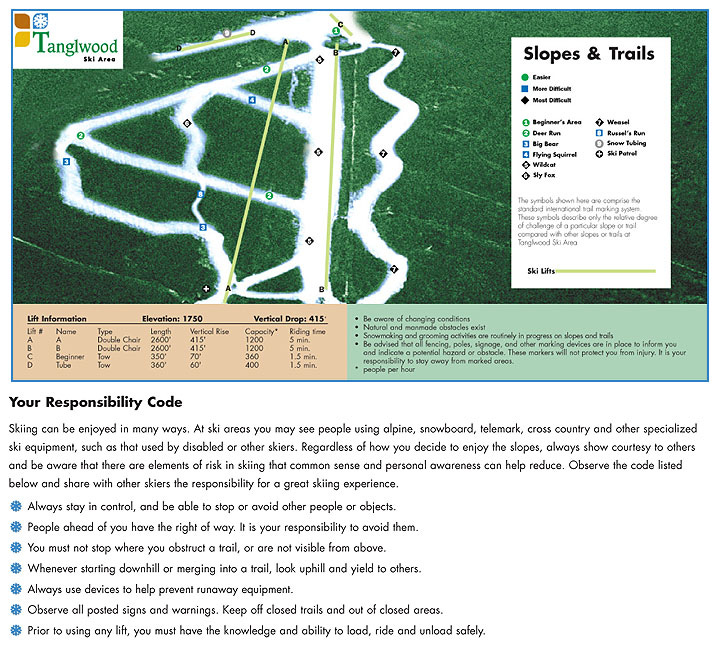
I spent a few hours hiking the place back in 2021. Here’s what I wrote at the time:
Another 40 minutes up wild Pennsylvania highway is Tanglwood, 415 vertical feet shuttered since 2010. The mountain once had two doubles and two T-bars and a ropetow but now it has nothing, the place stripped as though looted by a ski grinch stuffing the chairs and tower guns into his wicked sleigh. Concrete lift towers anchored into the forest and the trails themselves are all that remain. The place is filled with deer. Like all the ski areas I visited that day it is lined with houses. It is late in the day and the American mole people are emerging to stand on their decks and tend to their plants and I wonder what it would be like to live on a ski area and then not live on a ski area because the ski area is gone and now you just live on a mountain where it hardly ever snows and you can hardly ever ski. I think I would be pissed.
On Maple Valley, Vermont
Kreischer also considered resurrecting Maple Valley, a thousand-footer in Southern Vermont. It had a nice little spread:
The place opened in 1963 and made it, haltingly, to the end of the century under a series of owners. The culprit was likely a very tough neighborhood – Southern Vermont skiers have their choice of Stratton, Mount Snow, Bromley, or Magic. Maple Valley was just a little too close and a little too small to compete:
I also included Granite Gorge on the map, so you can see how close the place is. I wouldn’t have bet on Granite to re-open before Maple if pure ski terrain were the only factor to consider. But a fellow named Nicholas Mercede tried twice to open the ski area, according to New England Ski History. NIMBYs beat him back, and he died in 2018 at age 90.
The lifts – a pair of 1960s Hall doubles – are, I believe, still standing. An outfit called “Sugar Mountain Holdings” has owned the ski area since 2018, and “a long-term vision was announced for possibly reopening the ski area,” according to New England Ski History.
On Ski Resort Tycoon, the videogame
Kreischer’s first run at ski resort management came via Ski Resort Tycoon, a 2000 sim game that you can still purchase on Amazon for $5.95. According to Wikipedia, “A Yeti can also be seen in the game, and it can be found eating the guests.” My God, can you imagine the insurance bill?
On the density of New England ski areas
New England is one of the most competitive ski markets on the planet. It’s certainly one of the densest, with 100 ski areas stuffed into 71,988 square miles – that’s an area small than any major western ski state. The six New England states are small (Maine occupies nearly half of the total square mileage), so they share the glory, but their size masks just how tightly they are clustered. Check this stat: the number of ski areas per square mile across the six New England states is more than four times that of Colorado and six times that of Utah:
Of course, New England ski areas tend to measure far smaller than those of the West. But the point of this exercise is to underscore the sheer volume of choices available to the New England skier. Here’s what Granite Gorge is competing against as it works to establish itself as a viable business:
That means the ski area is fighting against heavies like Mount Snow, Okemo, Stratton, and Mount Sunapee for its local Keene market – and the Keene market is essentially Granite Gorge’s only market. There’s probably a place for this little knuckler to act as a new-skier assembly line and weekend hideout for families and teenage Park Bros, but there’s probably not a tougher place in America to pull this off than southwest New Hampshire.
On Granite Gorge’s mountain bike park and better glade skiing
Kreischer believes that Granite Gorge cannot survive as a winter-only business. Earlier this spring, he announced the construction of a downhill mountain bike park. You can track their progress via Instagram:
As regular readers know, I don’t cover MTB, but we discuss these new trails in the context of their potential to enhance the ski area’s glade network. Very little of Granite Gorge’s face has been cut with trails. The potential for glade development is huge, and this initial poke into the forest is an excellent start.
On Highland bike park
Kreischer and I briefly discuss Highland Bike Park in New Hampshire. This is the only lift-served MTB park in New England that doesn’t also double as a ski area. It was, in fact, once a 700-vertical-foot ski area. Here’s a circa 1987 trailmap:
Highland closed for skiing in 1995, and re-opened as a mountain bike park at some point over the next dozen years. Bike people tell me that the place is one of the best-regarded MTB facilities in New England. Here’s the current bike trailmap:
There are no current plans to re-open the area for skiing. “While there have been rumors that limited ski operations could resume in the future, the park remains biking-only at this point,” according to New England Ski History.
Highland is in a tough spot for skiing, lodged between Ragged and Gunstock, which both have high-speed lifts and far more vertical. Highland sits just over two miles off Interstate 93, however, and there could be room in the market for a terrain-park only mountain à la Woodward Park City. Loon is the current terrain park king of New Hampshire, but it’s crowded and expensive. Imagine a parks paradise with $50 day tickets and $300 season passes. That could work.
On the alarm beeping in the background
You may notice an alarm beeping in the background during the latter half of the podcast. I thought this was on my end, and I planned to simply edit the noise out, since I’m listening most of the time. After the podcast, I came up the stairs toting a ladder, prepared to dismantle the fire alarm. My wife looked at me, baffled. “What beeping?” she asked. Well, it was on Keith’s end. Hopefully he wasn’t so devoted to the podcast that he let his house burn down while recording it. Though I doubt that. Maybe he is Batman and that was his Batman alarm alerting him to nearby crimes. Though frankly I’m not sure a superhero could have revived Granite Gorge in six months. So it was probably just his You’re Awesome alarm going off. All part of the story here.
On an assist from Pats Peak
Keith followed up via email after our call to throw some credit to his contemporary at Pats Peak:
“I was reflecting on our conversation last night and one huge thing I forgot to mention was Kris Blomback and the help from Pat's Peak. They were instrumental in giving us a patrol sled and some awesome rental equipment that was a big deal getting us going this season. Kris is an amazing guy and a great leader. When I listened to his podcast episode with you, his words of advice to me was virtually verbatim, which really showcases his honesty, class, and true passion for bolstering skiing in this region. I really want to thank Kris and the rest of the Pats team for their help and assistance bringing us back to being a feeder for the entire Southern NH region.”
On New Hampshire skiing
I am an enormous, unapologetic fan of New Hampshire skiing. The mountains are many and varied, each one distinct. I’ve hosted a number of New Hampshire resort leaders on the podcast, and I have conversations scheduled with Cranmore GM Ben Wilcox and Attitash GM Brandon Swartz later this year. I also recorded an episode with Dartmouth Skiway GM Mark Adamczyk earlier this week – you’ll have that one soon. Here’s what’s in the catalog right now:
Loon Mountain GM Brian Norton – Nov. 14, 2022
Pats Peak GM Kris Blomback – Sept. 22, 2022
Ragged Mountain GM Erik Barnes – April 29, 2022
Whaleback Executive Director Jon Hunt – June 17, 2021
Waterville Valley President and GM Tim Smith – Feb. 23, 2021
Gunstock President and GM Tom Day – Jan. 13, 2021
Cannon Mountain GM John DeVivo – Oct. 12, 2020
Loon Mountain President and GM Jay Scambio – Feb. 7, 2020
The Storm publishes year-round, and guarantees 100 articles per year. This is article 51/100 in 2023, and number 437 since launching on Oct. 13, 2019. Want to send feedback? Reply to this email and I will answer (unless you sound insane, or, more likely, I just get busy). You can also email skiing@substack.com.



